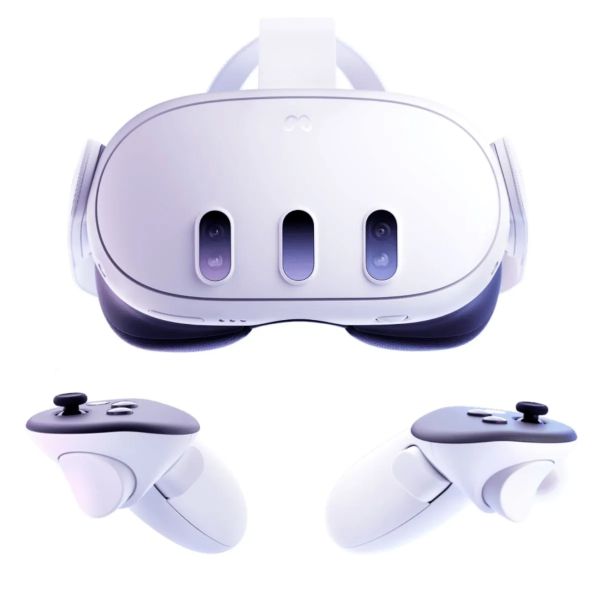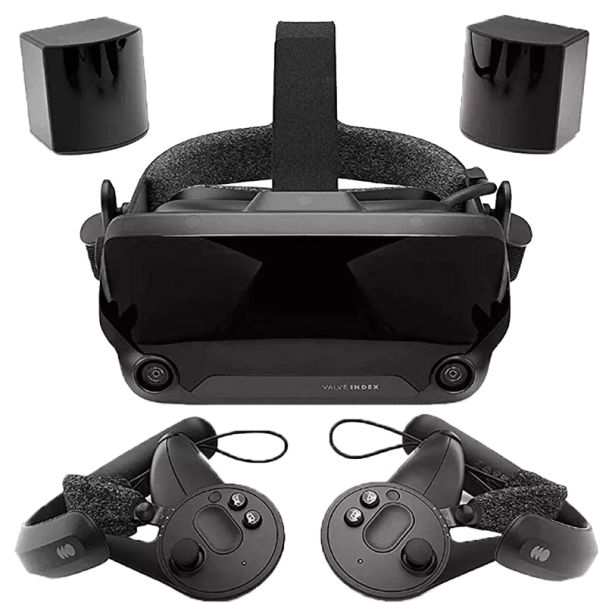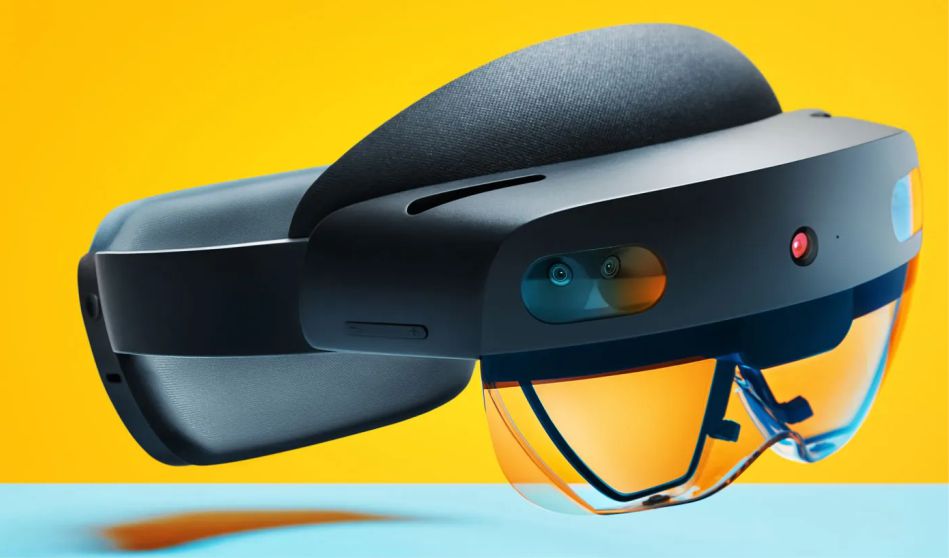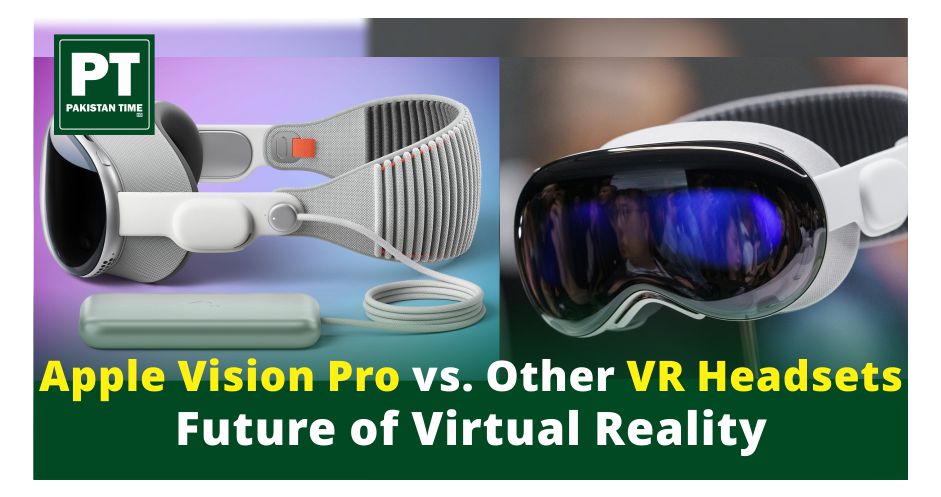Apple Vision Pro vs. Other VR Headsets: Future of Virtual Reality
Apple Vision Pro
Apple’s highly anticipated mixed-reality headset, the Vision Pro, is finally here, marking a significant leap forward in personal computing. Launched in February 2024, the Vision Pro has quickly garnered attention for its groundbreaking features and immersive experiences. In this article, we will take a closer look at what makes the Vision Pro so special and how it is poised to revolutionize the way we interact with technology.
A Vision of the Future:
The Vision Pro is not just a screen strapped to your face; it is a portal to a new dimension. Imagine immersing yourself in breathtaking virtual landscapes, manipulating 3D objects as if they were right in front of you, or collaborating with colleagues in a shared virtual workspace. The possibilities are endless, and Apple’s VisionOS operating system is specifically designed to make interacting with this new reality intuitive and seamless.
Apple VR Headset: Stepping into the Next Dimension
Apple’s foray into the world of virtual reality (VR) has been highly anticipated, and with the recent launch of the Apple Vision Pro, the wait is finally over. This mixed-reality headset (MR) blends the physical and digital worlds, pushing the boundaries of what is possible in personal computing.
Apple Vision Pro is a standalone VR headset that was announced in June 2023 and is expected to be available in early 2024 in the U.S. It features a sleek design, high-resolution micro-OLED displays, spatial audio, eye, hand, and voice tracking, and a 3D camera. It also supports various apps, entertainment, photos, videos, and connection features. The headset is priced at $3499 in the U.S.
Benefits of the Apple Vision Pro
The benefits of the Apple Vision Pro are that it offers a new way of experiencing mixed reality, which is a blend of both VR and AR. It allows users to interact with digital content in their physical space using their eyes, hands, and voice. It also enables users to enjoy immersive entertainment, capture and relive spatial photos and videos, and collaborate and connect with others in a more meaningful way. The headset is designed to be comfortable, elegant, and powerful, with advanced technology and an intuitive interface.
The specs and features of the Apple Vision Pro are as follows:
- Enclosure: A singular piece of three-dimensionally formed laminated glass that flows into an aluminum alloy frame that curves to wrap around your face.
- Light Seal: The Light Seal gently flexes to conform to your face, delivering a precise fit while blocking out stray light.
- Head Band: The head band provides cushioning, breathability, and stretch.
- Displays: Two micro-OLED displays with a resolution of 4096 x 3072 pixels per eye, a refresh rate of 120 Hz, and a field of view of 110 degrees.
- Audio: spatial audio with six speakers and two microphones.
- Camera: A 3D camera with a resolution of 12 megapixels and a frame rate of 60 fps.
- Sensors: Five sensors, including an accelerometer, a gyroscope, a magnetometer, a proximity sensor, and an ambient light sensor.
- Chips: an M2 chip and an R1 chip for real-time processing of 12 cameras, 5 sensors, and 6 microphones.
- Battery: An external battery pack that attaches to the back of the headband and provides up to two hours of battery life.
- Connectivity: Wi-Fi 6, Bluetooth 5.2, and USB-C.12
The Potential of the Apple VR Headset:
The applications of VR extend far beyond gaming and entertainment. Here are just a few examples of how VR is being used to make a difference in the world:
- Education: Imagine exploring the pyramids of Egypt or dissecting a frog in virtual reality. VR can bring learning to life in a way that traditional methods simply cannot.
- Healthcare: VR is being used to help patients with anxiety, phobias, and post-traumatic stress disorder. It can also be used to train medical professionals in a safe and realistic environment.
- Architecture and Design: Architects and designers can use VR to walk through a building before it is even built, making it easier to identify and fix any potential problems.
- Manufacturing and Training: VR can be used to train workers on new equipment or procedures in a safe and controlled environment.
Apple Vision Pro vs. Other VR Headsets
Apple’s Vision Pro has entered the ring of mixed reality (MR) headsets, shaking things up with its innovative features and sleek design. However, how does it fare against the established players? Let us compare it to three leading contenders:
Meta Quest 3:

The Quest 3 is the latest iteration of Meta’s standalone VR headset series. It boasts:
- Affordability: Priced at $499, it is significantly cheaper than the Vision Pro ($3,499).
- Standalone VR: No need for external wires or computers, making it a truly mobile VR experience.
- Large Content Library: Meta’s Quest platform has a vast library of VR games and experiences, giving you more choices.
However, it may fall short in some areas:
- Processing Power: The Quest 3 uses a Qualcomm Snapdragon XR2+ Gen 1 chip, which is less powerful than the Vision Pro’s M2 and R1 chip combination. This could lead to performance issues in demanding applications.
- Limited Mixed Reality: While it offers a pass-through camera view, its mixed reality capabilities are not as advanced as the Vision Pro’s.
- No Eye Tracking: The Vision Pro’s eye tracking tech allows for more intuitive interaction and natural gestures, which the Quest 3 lacks.
Valve Index:

The Valve Index is a high-end PC VR headset known for its:
- Room-Scale Tracking: With external sensors, it offers precise tracking for a wider range of movement than most standalone headsets.
- High-Fidelity Display: Dual OLED displays with a 144Hz refresh rate deliver smooth and crisp visuals.
- Knuckles Controllers: Innovative finger-tracking controllers provide unparalleled hand presence in VR.
However, it also comes with its drawbacks:
- Expensive: At $999, it is even pricier than the Vision Pro.
- Requires a Powerful PC: You need a high-end computer to run the Index to its full potential, adding to the overall cost.
- Wired Setup: The reliance on cables can be restrictive and cumbersome compared to standalone headsets.
Microsoft HoloLens 2:
The HoloLens 2 is a pioneer in augmented reality (AR) headsets, designed for professional applications.

- Advanced AR capabilities: Its high-resolution displays and precise tracking overlay digital information onto the real world seamlessly.
- Enterprise Focus: Built for tasks like field engineering, medical training, and remote collaboration.
- Comfortable Design: lightweight and well balanced, suitable for extended wear during work.
However, it falls short in some consumer-oriented aspects:
- Price: At $3,500, it is even more expensive than the Vision Pro and not ideal for casual users.
- Limited VR Capabilities: Primarily an AR headset, its VR experiences are not as polished as dedicated VR devices.
- Complex Setup: Requires calibration and setup specific to its unique technology.
Apple Vision Pro: A Compelling Contender
While the Vision Pro’s high price tag may be a barrier for some, its cutting-edge features and seamless blended reality experience make it a compelling contender in the MR market. Here is how it stacks up:
- Processing Power: The M2 and R1 chip combinations deliver exceptional performance for both VR and AR applications.
- Advanced Mixed Reality: The high-resolution displays, 12 ms pass through latency, and eye tracking create a remarkably immersive and realistic mixed reality experience.
- Seamless Apple Integration: Designed to work seamlessly with other Apple devices and services, providing a smooth and familiar user experience.
Choosing the Right Headset:
Ultimately, the best headset for you depends on your needs and budget. If you are looking for a powerful and portable MR experience with seamless Apple integration, the Vision Pro is worth considering. However, if you are on a tighter budget or prioritize affordability and content library, Quest 3 might be a better option. The Valve Index caters to high-end PC VR enthusiasts, while the HoloLens 2 excels in professional AR applications.
Remember, the VR and MR landscape is constantly evolving, with new developments and innovations emerging frequently. Therefore, keeping an eye on the latest advancements and considering your specific needs will help you choose the headset that is right for you.
Apple Vision Pro VR Headset Price in Pakistan
The price range of the Apple Vision Pro varies depending on the region and its availability. In the U.S., the headset is priced at $3499, which is very expensive compared to other VR headsets on the market. According to one source, the Vision Pro is priced at approximately ₨.983,490 in Pakistani rupees.








